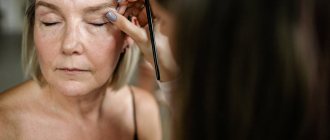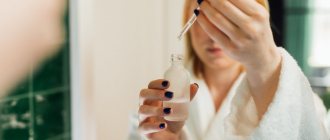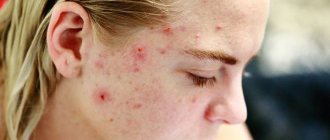The colloquial expression - acne unites a fairly large group of inflammatory foci of different structures: milia, pustules, acne, comedones, etc. Inflammation of the epidermis is most often a consequence of hormonal imbalance in the body. How to cure hormonal acne and whether it is possible, we will consider in this article.
Unaesthetic painful formations on the skin of the face cause a lot of inconvenience and suffering to women. So-called pimples or acne are pronounced bumps with purulent, greasy or watery contents, which are localized on the face, less often - the neck and chest. The mechanical reason for the occurrence of inflamed lesions is the blockage of the sebaceous glands and hair follicles with dirt, grease and microorganisms. The colloquial expression - acne unites a fairly large group of inflammatory foci of different structures: milia, pustules, acne, comedones, etc. Inflammation of the epidermis is most often a consequence of hormonal imbalance in the body. How to cure hormonal acne and whether it is possible, we will consider in this article.
Cause of acne in women
Exocrine, that is, sebaceous glands are part of the endocrine system and a protective mechanism for the epidermis. The glands produce sebum, which is a barrier to pathogenic microorganisms. The second function of the exocrine glands is to maintain the water balance of the skin, moisturize it and nourish it with antioxidants, lipids, and pheromones. Steroid sex hormones are responsible for the regulation and formation of sebum in the glands of women. Male sex hormones (androgens) are also produced in a woman’s body and play their own special role. A certain amount of androgens has a positive effect on the development and stabilization of various processes in a woman’s body. But their excess - hyperandrogenism causes pathological conditions, such as:
- menstrual irregularities;
- infertility;
- male pattern hair growth;
- obesity;
- dandruff and seborrhea;
- acne.
The occurrence of acne is associated with hypersecretion of sebum at androgen receptors, which occurs due to decreased estrogen levels and increased testosterone production. As a result of an increase in the amount of male hormones, horn cells rapidly divide, and follicular hyperkeratosis develops. Excess keratin and sebum clog the pores of the epidermis and decompose under the influence of bacteria. Lipids are produced in reduced quantities, the skin becomes dry and inflamed.
Causes of facial allergies
Atypical reactions of the immune system to foods, chemicals and biological substances can cause rashes, pimples, redness, swelling and itching. The person experiences physical and moral discomfort. The manifestations of allergic reactions are varied and depend on the individual characteristics of the body. Most often, localization is observed on the forehead, temples, cheeks, behind the ears, in the décolleté area and on the neck. The most common prerequisites for allergies are:
- heredity;
- consequences of long-term use of medications;
- unfavorable environment;
- constant stress;
- reduced immunity;
- too high a concentration of certain substances;
- insect bites;
- cold or direct sunlight.
There may be other reasons; you need to approach the problem individually.
Allergies to foods and medications
There is often cross-reaction to the protein in this group, making it difficult to find the source. The speed of onset of symptoms can vary from immediate to a period of 2-3 hours. In the case of medications, the prerequisite is overdose, long-term use, too many drugs taken during the day.
Sun or cold
The body’s response is characteristic not only of winter. This could be water or food at a certain temperature. The appearance of photodermatitis is promoted by internal and external causes. Within a day or a little later after exposure to the sun, soreness and itching of the skin begin to bother. When an allergic rash appears on the face of an adult, treatment should begin immediately, otherwise the situation will worsen with each passing hour. As part of complex therapy, immunostimulating cosmetics such as Laennec are effective. Before use, you should consult with specialists.
Reaction due to eczema
Skin diseases significantly reduce the body's resistance, and any violation provokes their exacerbation. Most often, the reaction appears externally in the form of small bubbles with liquid. The acute form can become chronic, which subsequently leads to relapses.
Errors in diet
Various dietary restrictions do not go out of fashion. There are programs based on the consumption of one or just a few products for a long time, which leads to an oversaturation of the body with certain elements, since in this case there can be no talk of balance. You should not be surprised at the deterioration in well-being, since such restrictions become the causes of severe allergies on the face of an adult, the treatment of which is carried out comprehensively and will take a lot of time.
We recommend
GHC Placental 3D Mask withQ10
Serum concentrate
Repairing cream with a moisturizing effect
Placental antioxidant lotion concentrate
Contact with animals, insect bites
A swollen nose and watery eyes when trying to pet a pet are a true classic of the genre. Mosquitoes, bedbugs and other blood-sucking creatures can also cause itching and redness on the skin. The toxins they inject in large quantities cause a rash, often accompanied by fever. In this case, external agents and antihistamines are recommended; dosages should be confirmed with a doctor.
Allergies due to stress
In addition to nervous tics, there are other reactions to emotional overload. Unconsciously, a person may scratch or clench their hands tightly. If such situations happen regularly, then health problems may begin. Itching, swelling of certain areas, redness, and difficulty breathing appear. The main direction of stabilizing the condition is the prescription of sedatives, breathing exercises aimed at calming the nervous system, ointments and gels to relieve external manifestations on the skin.
Hormonal acne: what tests to take?
Acne treatment begins with a visit to a dermatologist and gynecologist, who will determine the possible causes of the disease through a comprehensive examination. The gynecologist prescribes smears for sexually transmitted pathologies (STDs and STIs), and inflammatory processes. A blood test for RW (syphilis) and HIV is mandatory. The dermatologist prescribes a whole range of specific tests of blood, urine, and skin.
Since women with acne are expected to have a disorder of the endocrine system, they need to undergo laboratory diagnostics to determine their hormonal status. The list of tests includes a mandatory test for the concentration of adrenal hormones. Paired glands located at the apex of the kidneys produce three groups of steroid hormones: mineralcorticoids, glucocorticoids, and sex hormones: androgens, estrogens, progesterone. The doctor prescribes a blood test for testosterone, dihydrotestosterone, progesterone, estradiol, FSH (follicle-stimulating hormone). It is also necessary to check the level of thyroid hormones: TSH, T3, T4. In addition, doctors prescribe general and biochemical blood and urine tests.
Acne skin care
In addition to a visit to a gynecologist-endocrinologist who will prescribe appropriate hormonal treatment, proper daily skin care for acne is very important:
- Choose a good acne treatment cream
. Preparations containing salicylic acid, alpha hydroxy acids, lactic, glycolic or azelaic acid have antimicrobial, anti-inflammatory, exfoliating and healing properties. - Thorough facial cleansing is necessary
. Using makeup removers alone is not enough; you also need to wash your face with plain water, toner or micellar liquid. After properly cleaning the skin, the cotton swab should be completely clean. - Use exfoliating products.
Peels are the most recommended. As a rule, one procedure per week is sufficient. However, peeling should not be used by people with delicate, sensitive skin as it may cause irritation. - Limit decorative makeup.
It is not recommended to use a thick layer of foundation and powder, which additionally blocks the openings of the sebaceous glands and increases inflammatory changes in the skin.
It is important to remember that treating acne in adults is a long and difficult journey, so you should be patient and work on leading a healthy lifestyle. The condition of the whole organism depends on how we live. Regular exercise, quitting smoking, and a well-balanced diet provide invaluable assistance in the process of acne therapy.
Proper nutrition
How to cure hormonal acne
Chronic inflamed acne on the face due to hormonal imbalance is treated exclusively in an inpatient or outpatient setting based on a confirmed diagnosis. The doctor prescribes hormonal therapy according to a special regimen, prescribes a diet and gives recommendations for mechanical cleaning and treatment of the affected areas of the epidermis. Treatment of identified gynecological ailments and vitamin therapy are mandatory. All stages of complex treatment, used together, and under the strict supervision of a dermatologist and gynecologist, will allow a woman to get rid of a serious problem and live enjoying clear facial skin.
Symptoms of acne (acne)
- Increased oiliness of the skin of the face and head (increased sebum production);
- Small or large red rash;
- The appearance of white ulcers;
- Soreness of the skin in the areas of the rash;
- Scars and pigmentation after acne heals.
In the first stage, acne affects only certain areas of the face - most often the forehead, cheeks and chin. In the future, acne spreads to the neck and chest areas. At the third stage, ulcers and acne increase in size, covering increasingly large areas of the skin, and after healing they leave large scars.
Squeezing pimples and blackheads (comedone extraction)
For comedonal and papulopustular forms of acne, invasive methods are sometimes used, for example, comedonal extraction. Extraction means their removal/squeezing out - using special comedones extractor tools, or by palpation. Moreover, we are talking about the removal of macrocomedones, i.e. large eels. But squeezing out pimples (papules and pustules) can, at best, lead to the appearance of a hyperpigmented spot in this area in the future.
In the worst case, self-squeezing pimples and blackheads can lead to the spread of inflammation and the formation of deep subcutaneous pimples, which will leave superficial or deep atrophic scars on the skin. Therefore, only comedones (acne) can be squeezed out, and secondly, this should only be done by a dermatologist or a dermato-cosmetologist. The procedure is called “mechanical facial cleansing.”
Mechanical facial cleansing: video
Important: keep in mind that the removal of comedones is much easier and without complications if the patient has previously used topical retinoids for at least 3-4 weeks. The fact is that topical retinoids (adapalene) also have comedonolytic properties.
Why is it important to treat acne?
At first glance, it seems that acne is a purely skin disease. The classic development scenario is as follows: excess synthesis of subcutaneous fat, accumulation of keratinized cells - blockage of the sebaceous glands, inflammation of the hair follicle - pimple. In fact, this is an external manifestation of internal problems.
Skin rashes serve as an SOS signal for the body. Pimples and their localization are a kind of messenger through which information about organ problems is transmitted. A special guide map “Types of acne and what they mean” has been compiled. This is a kind of projection of internal organs onto areas of the face:
- forehead - small intestine;
- eyelids and area around the eyes - kidneys;
- temporal region – gallbladder;
- middle third of the face, cheekbones – stomach;
- chin – pelvic organs;
- nose – pancreas;
- lower third of the face, lower jaw – lungs.
When acne is detected on the face and body, several reasons are considered:
- Imbalance of sex hormones. An increase in the concentration of the male hormone (testosterone) leads to hypersecretion of the sebaceous glands and hyperproduction of sebum. To confirm, a test for sex hormones is taken, and a consultation is held with a gynecologist to exclude diseases of the pelvic organs.
- Liver diseases. This “filter” of the body can become “clogged” during cleansing of toxins from the blood. A similar failure is reflected on the skin. You can check your assumptions by donating blood for biochemistry.
- Digestive problems. Impaired intestinal motility and peristalsis, frequent constipation contribute to intoxication and the appearance of acne. There is a reason to visit a gastroenterologist and get tested for dysbacteriosis.
- Infections. Streptococci and staphylococci provoke acne. If pus is present along with serous fluid, a bacterial culture is done and antibacterial treatment is prescribed.
- Weak immunity. Often ARVI/ARI are accompanied by purulent rashes.
- Allergy. A spontaneous rash may be the result of an allergic reaction. To prevent it from recurring in the future, it is necessary to identify the factor causing hypersensitivity. To do this, allergy tests are performed.
Cosmetical tools
The use of comedogenic cosmetics is another reason why acne on the cheeks can get worse and not go away for a long time. Long-term use of fatty creams, which contain, for example, isopropyl myristate, is a common cause of cosmetic acne in the form of comedones. When purchasing skincare products, you should opt for products labeled “non-comedogenic” or “non-acnegenic”
Moderate sun exposure has a disinfecting effect on the skin and dries out purulent rashes. However, excessive abuse of ultraviolet radiation (on the beach, in the solarium) has the opposite effect. The top layer of skin dries out, which acts as a signal to the sebaceous glands, and they begin to intensively produce secretions. Therefore, prolonged sun exposure provokes an exacerbation of existing acne and the appearance of new ones.
Nutrition and habits
Foods high in carbohydrates can increase the concentration of insulin in the blood. Insulin, in turn, increases androgen levels. The result of this connection is an increase in sebum production and acne.
For existing rashes, excessive consumption of seafood, as well as foods high in iodine and bromine, can aggravate the situation.
Diet for acne is considered one of the links in complex therapy. You should include foods rich in fiber, Omega-3 acid, and vitamins A, C, and E into your diet.
One of the factors contributing to the appearance of acne is the habit of smoking. Nicotine reduces vitamin E concentrations and increases sebum production.
Estrogen
It is rightly called the hormone of beauty and femininity. Maintaining adequate estrogen levels is important because it provides the following134:
- stimulation of hyaluronic acid production, maintaining a sufficient level of skin moisture;
- elasticity, beauty and strength of nails and hair;
- active regeneration processes;
- collagen synthesis;
- maintaining skin metabolism.
If there is a lack of estrogen in the body, hormone replacement therapy may be prescribed.
D-hormone
It will be news to many that vitamin D is both a vitamin and a steroid hormone134. It is mainly synthesized under the influence of UV radiation. Maintaining normal vitamin D levels contributes to the following134:
- epidermis regeneration;
- healing damaged skin;
- production of proteins, elastin, collagen.
A deficiency of vitamin D can be compensated for by eating foods rich in vitamin D and taking medications prescribed by a doctor.











